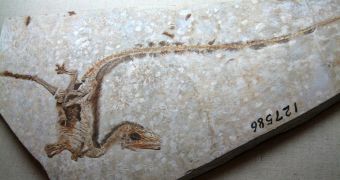In a scientific paper published in the latest issue of the esteemed scientific publication Nature, researchers in China detail the appearance of a small dinosaur that lived more than 125 million years ago. Known as Sinosauropteryx, the tiny animal, which wasn't even tall enough to reach your knee, appears to have been covered in brightly colored feathers, experts from China and the United Kingdom say. According to their reconstruction of the creature, it sported a “Mohican” hairdo, with feathers going from the top of its head to its back, and standing upright. Its tail seems to have been striped as well, the BBC News reports.
The recent investigation was at first conducted on the creature Confuciusornis, a sort of bird that lived at the same time as Sinosauropteryx, at the beginning of the Cretaceous Period. Experts were able to recently discover an amazingly well-preserved specimen in northern China, and they proceeded towards analyzing it with a very powerful imaging tool, an electron microscope. The target of this study was the inside of the bird's feathers. The researchers determined the existence of structures known as melanosomes inside, which are generally employed to store the pigment melanin.
“Melanin is what gives color to human hair and animal fur. They are also the most common way that colors are [produced] in feathers,” University of Bristol expert, Professor Mike Benton, who has also been the leader of this investigation, says. The scientist goes on to explain that different shapes of melanosomes produce different colors. For example, those that are “sausage-shaped” produce blacks or grays, whereas those that are more spherical produce reddish colors. “A ginger-haired person would have more spherical melanosomes, and a black-haired or grey-haired person would have more of the sausage-shaped structures,” the expert explains. Sinosauropteryx was found to have ginger-colored feathers, too.
“This is the first time anyone has ever had evidence of original colour of feathers in dinosaurs,” Benton says. “Critics have said that these visible spiny structures could be shredded connective tissue. But the discovery of melanosomes within the bristles finally proves that some early dinosaurs were indeed feathered. We now know that feathers did not originate as flight structures,” he adds. It may be that, originally, feathers played an important part in mating rituals, and in thermal insulation.

 14 DAY TRIAL //
14 DAY TRIAL //